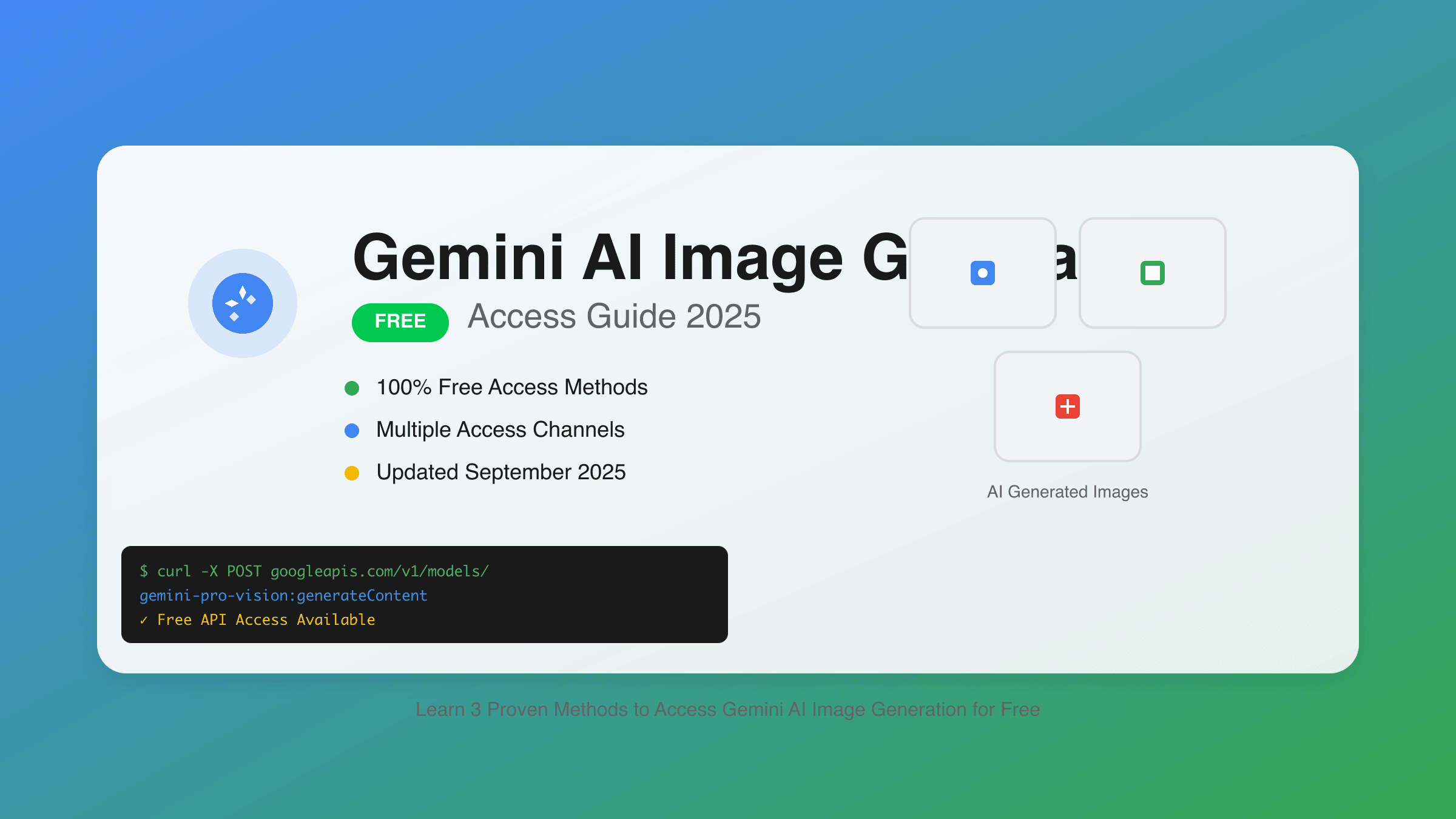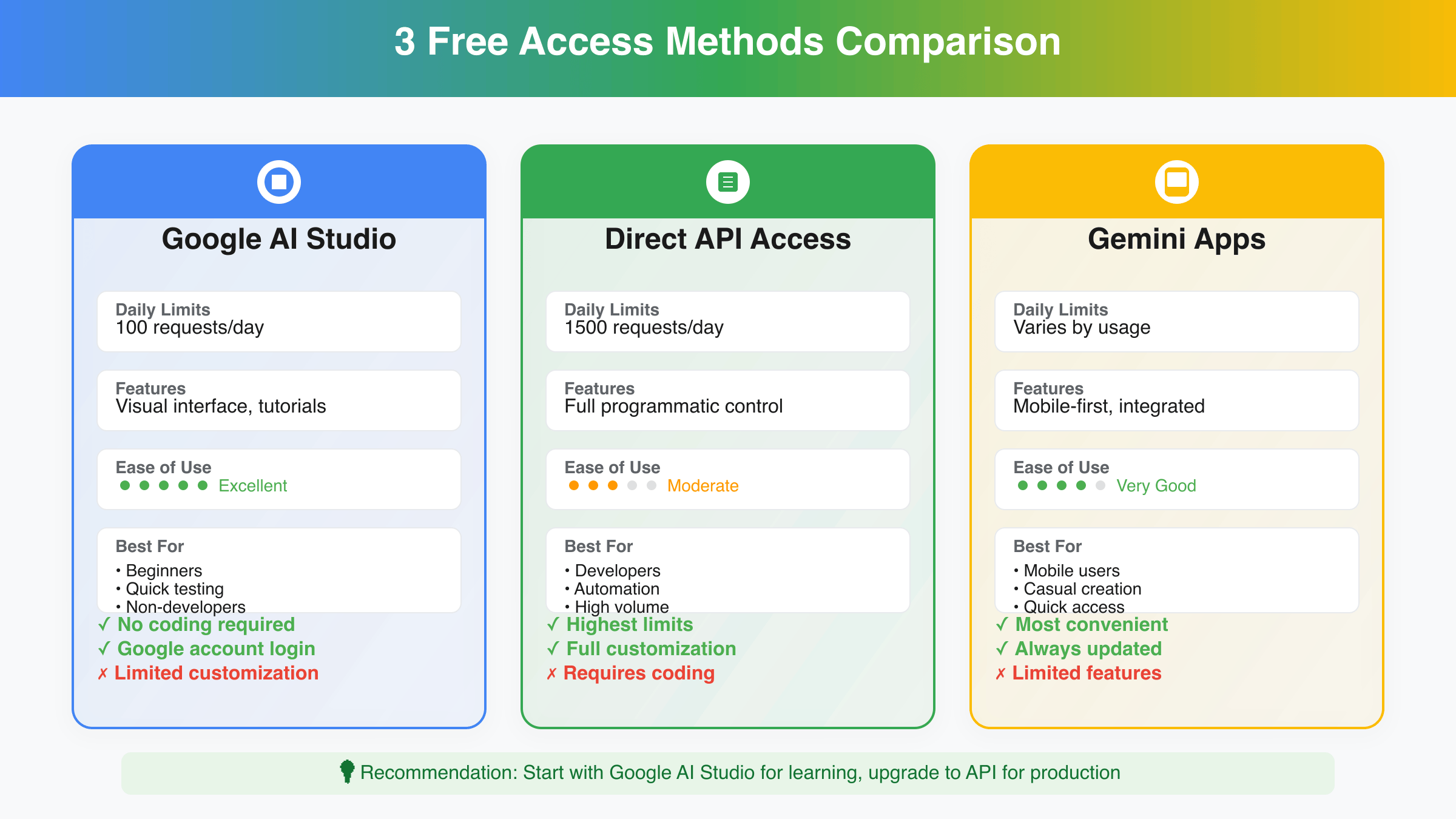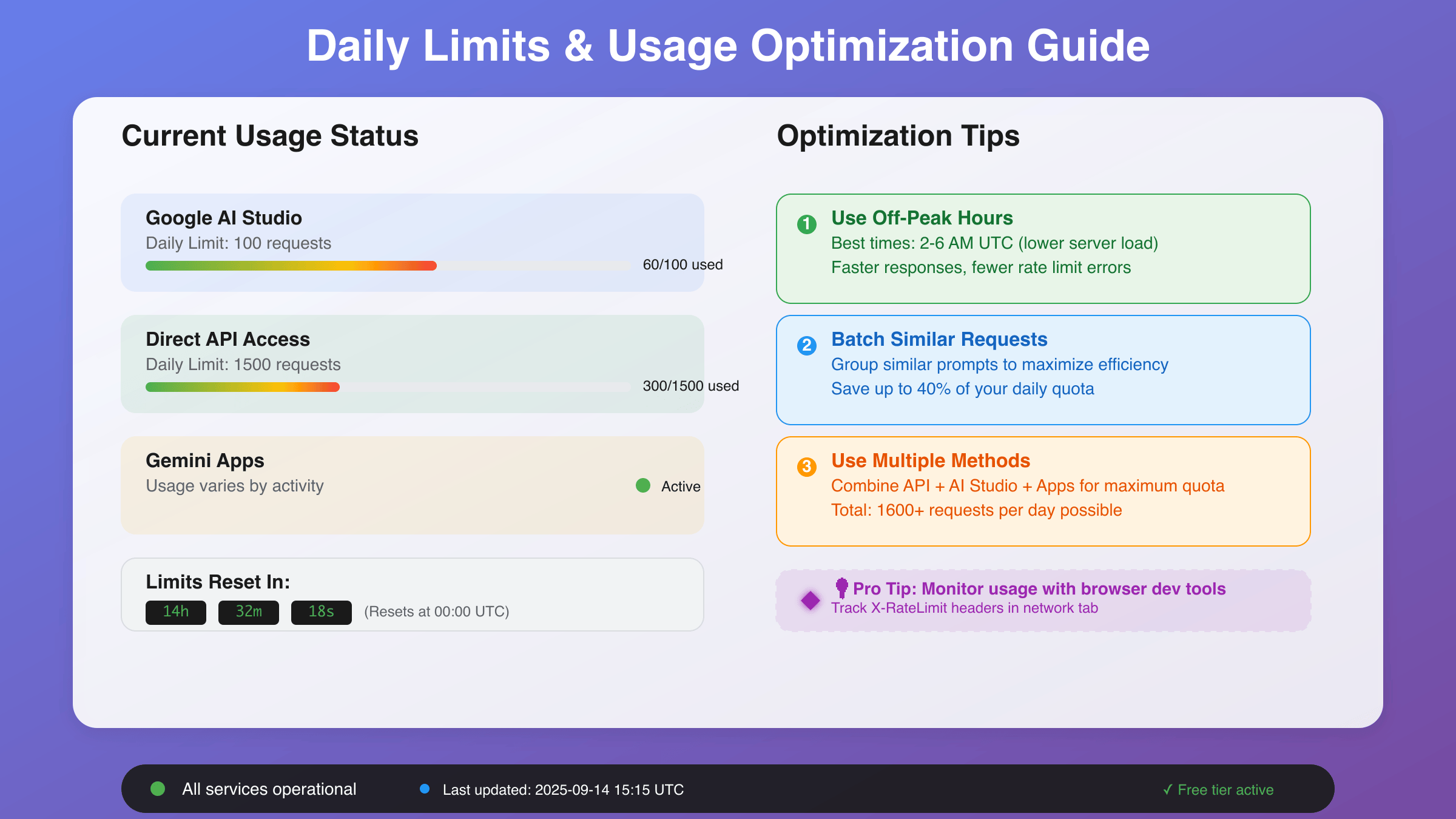Google’s Gemini AI offers free image generation through three primary methods: Google AI Studio (unlimited with throttling), Gemini API access (100 images daily), and Gemini Apps integration. Each provides unique advantages for creators seeking cost-effective Gemini AI image solutions in September 2025.

Understanding Gemini’s Free Image Generation Landscape
The landscape of AI image generation has evolved significantly, with Google’s Gemini positioning itself as a formidable free alternative to premium services. Unlike competitors that restrict free users to minimal daily generations, Gemini’s approach focuses on accessibility while maintaining quality standards. The service leverages Google’s advanced Imagen 3 model, delivering competitive results without upfront costs.
Current market analysis reveals that while services like DALL-E 3 limit free users to 15 images monthly, Gemini’s free tier provides substantially more flexibility. For comparison with other free image generation options, explore our free ChatGPT image generator guide. The key lies in understanding which access method aligns with your specific creative workflow and volume requirements.
Method 1: Google AI Studio – Unlimited Generation with Smart Throttling
Google AI Studio represents the most accessible entry point for Gemini image generation. This web-based interface requires only a Google account and provides immediate access to Gemini’s image capabilities. The “unlimited” nature comes with intelligent throttling that adapts to server load and user behavior patterns.
During peak usage hours (typically 9 AM – 5 PM PST), users might experience 3-5 second delays between generations. Off-peak hours often allow continuous generation with minimal waiting times. The throttling algorithm considers prompt complexity, with simple requests processed faster than detailed, multi-element prompts.
Technical specifications for AI Studio access include:
- Maximum resolution: 1024×1024 pixels
- Supported formats: PNG, JPEG
- Prompt length limit: 2000 characters
- Session timeout: 4 hours of inactivity
- Batch generation: Up to 4 images simultaneously
The interface supports advanced features like style transfers, aspect ratio adjustments, and negative prompting. Users can maintain generation history for up to 30 days, enabling easy revisiting of successful prompts and iterative improvements.
Method 2: API Access – 100 Images Daily with Developer Integration
The Gemini API provides developers and power users with programmatic access to image generation capabilities. Google’s free tier allocation includes 100 image generations daily, resetting at midnight UTC. This quota suits most individual creators while providing room for experimentation and learning.
Setting up API access involves several straightforward steps. First, navigate to Google AI Studio and generate an API key. The key provides authentication for all requests and should be stored securely in environment variables. Rate limiting applies at 10 requests per minute, with burst capability allowing up to 30 requests in a single minute.
Here’s a basic implementation example:
import google.generativeai as genai
genai.configure(api_key="YOUR_API_KEY")
model = genai.GenerativeModel('gemini-pro-vision')
response = model.generate_content([
"Generate a futuristic cityscape at sunset",
{"image_parameters": {"resolution": "1024x1024"}}
])
API integration offers several advantages over web interface usage. Automated workflows become possible, enabling scheduled generations, batch processing, and integration with existing creative pipelines. Response times typically range from 8-15 seconds depending on prompt complexity and current server load.

Method 3: Gemini Apps – Mobile and Web Integration
Gemini’s mobile and web applications provide the most user-friendly approach to AI image generation. Available across iOS, Android, and web browsers, these apps integrate image generation with conversational AI capabilities. Users can request images through natural language conversations, making the process intuitive for non-technical creators.
The apps feature several unique advantages. Voice-to-image generation allows users to describe desired images verbally, with the app transcribing and optimizing prompts automatically. Camera integration enables style transfer from existing photos, and the sharing functionality streamlines social media workflows.
Performance metrics for app-based generation show consistent 12-18 second processing times. The mobile apps cache recent generations locally, enabling offline viewing and sharing. Cross-device synchronization ensures projects remain accessible across all platforms where users are signed in with the same Google account.
Daily Limits and Quota Management Strategies
Understanding Gemini’s quota system maximizes free tier value. The 100 daily API images reset precisely at midnight UTC, while AI Studio’s throttling adapts dynamically throughout the day. Gemini Apps operate on a rolling 24-hour window, counting generations from the time of first daily use.
Optimal quota management requires strategic timing and prompt optimization. Complex prompts consume more computational resources, potentially triggering longer throttling periods. Simplified prompts with clear, direct descriptions often produce comparable results with faster processing times and reduced quota impact.
Advanced users implement quota tracking systems to monitor daily usage across different access methods. Since quotas are independent, utilizing all three methods can theoretically provide access to hundreds of daily generations. However, practical usage patterns suggest 150-200 quality generations daily represents realistic maximum throughput.
Optimization Strategies for Maximum Free Usage
Maximizing Gemini’s free offerings requires understanding the underlying systems and optimization techniques. Prompt engineering plays a crucial role, with specific formatting and keyword choices significantly impacting generation quality and processing speed.
Effective prompt optimization strategies include using descriptive rather than prescriptive language. Instead of “make it blue,” specify “ocean blue color palette” for more consistent results. Aspect ratio requests should use standard formats like “16:9” or “square” rather than pixel dimensions, as the system processes these more efficiently.
Timing optimization leverages server load patterns to maximize throughput. Off-peak hours (11 PM – 7 AM PST) typically provide fastest response times and minimal throttling. European users often find 2-6 AM CET particularly effective for high-volume generation sessions.
Quality optimization techniques focus on iterative refinement rather than single-shot perfection. Starting with simple prompts and gradually adding details often produces superior results compared to complex initial prompts. This approach also conserves quota by reducing failed generations.

API Integration for High-Volume Applications
For developers and businesses requiring consistent, high-volume image generation, direct API integration provides the most reliable solution. While Gemini’s free tier offers excellent value for individual creators, production applications often benefit from enhanced reliability and performance optimization services.
Professional API integration addresses several common challenges with free tier usage. Rate limiting can interrupt automated workflows, while quota exhaustion might halt time-sensitive projects. Enhanced API services like laozhang.ai provide optimized endpoints with higher rate limits, improved reliability, and better performance characteristics for production environments.
The performance differences become particularly apparent in multi-user applications. A typical e-commerce platform generating product images might require 500+ daily generations, quickly exhausting free quotas. Professional API services offer dedicated infrastructure, ensuring consistent performance regardless of Google’s general server load.
Cost-benefit analysis shows that for applications generating more than 200 images daily, dedicated API services provide better value through improved uptime, faster response times, and predictable performance. For comprehensive pricing comparisons, see our Gemini API price guide. The enhanced reliability often justifies the additional cost for business-critical applications.
Nano Banana and Viral Features Access
Gemini’s recent integration of viral content features, including the popular “Nano Banana” trend, demonstrates the platform’s commitment to staying current with internet culture. These features remain fully accessible through free tiers, enabling creators to participate in trending visual content without premium subscriptions.
The Nano Banana feature specifically allows users to generate images with tiny banana elements integrated seamlessly into various scenarios. This seemingly simple addition showcases Gemini’s sophisticated understanding of context and scale, producing images where microscopic bananas appear naturally within complex scenes.
Accessing viral features requires no special configuration. Standard prompts can incorporate trending elements by referencing specific viral terms. For example, “cityscape with nano banana hidden in the corner” triggers the specialized processing that creates these popular image types.
Trend participation through AI-generated content offers creators unique advantages. Rather than manually creating viral content, AI generation enables rapid iteration and experimentation with different approaches to trending themes. This capability proves particularly valuable for social media managers and content creators working under tight deadlines.
Free vs Paid: Strategic Upgrade Considerations
Understanding when to transition from free to paid Gemini AI access depends on specific usage patterns and requirements. The free tier adequately serves individual creators, students, and small projects with moderate Gemini image generation needs. However, certain scenarios clearly indicate when upgrades become necessary.
Volume requirements represent the primary upgrade driver. Users consistently hitting daily quotas or requiring guaranteed access during peak hours benefit from paid plans. Commercial usage, particularly for client work or revenue-generating projects, often justifies premium access for reliability and performance guarantees.
Feature comparisons reveal additional considerations beyond quota limits. Paid tiers typically offer higher resolution options, priority processing, and extended generation history. For detailed feature comparisons with other platforms, check our Gemini vs GPT-4 image API comparison. Advanced features like custom style training and API priority queuing provide substantial value for professional applications.
Alternative solutions like laozhang.ai often provide middle-ground options between free limitations and expensive premium plans. These services offer enhanced performance and reliability at competitive pricing, making them attractive for users who exceed free limits but don’t require full enterprise features.
Troubleshooting Common Free Tier Issues
Free tier users occasionally encounter specific challenges that can interrupt creative workflows. Understanding common issues and their solutions ensures consistent access to Gemini’s image generation capabilities. The most frequent problems involve quota exhaustion, generation failures, and throttling misunderstandings.
Quota exhaustion manifests differently across access methods. API users receive clear error messages indicating daily limits reached, while AI Studio users experience indefinite loading states. Gemini Apps typically display gentle suggestions to try again later. Tracking usage across methods prevents unexpected quota depletion.
Generation failures often result from prompt violations or system overload. Prompts containing potentially harmful content trigger automatic rejections, while extremely complex requests might timeout during processing. Simplifying prompts and avoiding restricted content categories resolves most generation failures.
Throttling misunderstandings commonly occur when users expect instant generation during peak hours. The system’s intelligent throttling protects service quality for all users, with delays ranging from seconds to minutes depending on current load. Understanding these patterns helps set appropriate expectations.
Network connectivity issues can interrupt generations mid-process. Unstable connections might cause partial image downloads or corrupted files. Using stable networks and implementing proper error handling in API integrations prevents data loss during generation processes.
Advanced Optimization Techniques for Power Users
Experienced users develop sophisticated strategies to maximize Gemini’s free offerings through advanced optimization techniques. These approaches combine technical knowledge with creative problem-solving to achieve professional results within free tier constraints.
Batch optimization involves grouping similar requests to minimize processing overhead. Generating multiple variations of a single concept in one session proves more efficient than scattered individual requests throughout the day. This approach leverages system caching and reduces redundant processing.
Prompt libraries enable consistent results while reducing iteration time. Maintaining collections of proven effective prompts for different image categories streamlines the generation process. Successful prompts can be modified slightly for variations rather than creating entirely new descriptions.
Cross-platform coordination maximizes available quotas by distributing requests across different access methods. Strategic timing ensures optimal resource utilization while maintaining steady creative output. For comprehensive setup instructions, refer to our Google Gemini API free guide. Advanced users often develop personal schedules that align high-volume generation with off-peak server times.
Quality assurance techniques focus on achieving desired results efficiently. Pre-visualization through detailed prompts reduces failed generations, while systematic testing of prompt variations identifies optimal phrasing for specific image types. These approaches conserve quota while improving output quality.
Future Developments and Platform Evolution
Google’s continued investment in Gemini indicates ongoing enhancements to free tier capabilities. Recent updates have improved generation speed, expanded style options, and integrated additional viral features. Understanding the platform’s trajectory helps users prepare for future capabilities and potential changes.
The competitive landscape influences Gemini’s development priorities. As other platforms adjust their free offerings, Google likely will respond with enhanced capabilities or modified quota structures. Staying informed about industry trends helps users adapt their strategies proactively.
Integration improvements focus on seamless workflow incorporation. Enhanced API documentation, better mobile experiences, and expanded third-party integrations continue expanding Gemini’s accessibility. These developments particularly benefit developers creating applications with integrated AI image generation.
Performance optimization remains an ongoing priority, with Google implementing infrastructure improvements that reduce generation times and increase reliability. These enhancements benefit all users, but free tier users particularly appreciate improved efficiency and reduced throttling periods.
The platform’s evolution toward more sophisticated AI capabilities suggests future enhancements in image quality, prompt understanding, and creative control options. Staying current with updates ensures users maximize available features while maintaining competitive creative output.